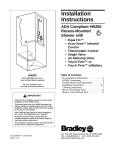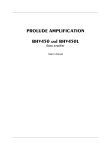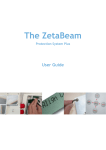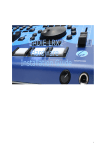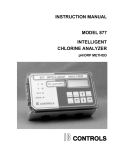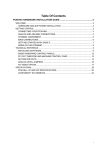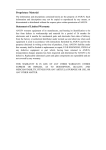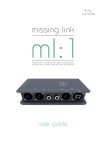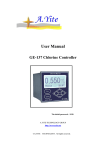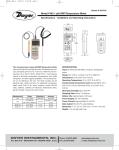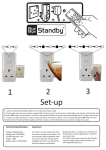Download 2262 user manual booklet
Transcript
SPECIFICATIONS MODEL 2262 pH/ORP TRANSMITTER - USER MANUAL Revision Date 20041201 POWER SUPPLY 9-36V DC OUTPUT SIGNAL 4-20mA INPUT Any standard pH or ORP combination electrode INPUT IMPEDANCE >30GS RANGE (options) 0 ~ 14pH 2 ~ 12pH 4 ~ 10pH -1000~+1000mV -2000~+2000mV ADJUSTMENT Standardize ± 1pH Slope 50% - 105% of nominal electrode output The model 2262 solves this problem by converting the signal from the electrode into a standard 4~20mA process signal. ACCURACY <±0.2% F.S. typical The 4~20mA signal is an industry standard which can be used with simple alarm circuitry or sophisticated PLC and computer monitoring systems. 4~20mA signals have three advantages over voltage signals for industrial applications. TEMPERATURE COMPENSATOR Pt100 Standard Pt1000, Ni3000 (Balco) optional 1. Better noise immunity. OPERATING TEMPERATURE -5 to +65°C 2. Longer cable runs because cable resistance does not affect calibration. 3. Only two wires are required to provide both power and signal. AMBIENT HUMIDITY 0 to 90% RH Non Condensing pH & ORP (oxygen reduction potential or redox) electrodes are high impedance devices which produce a mV signal proportional to the pH or ORP of a solution. It is not always easy to use this signal directly for process control applications, especially where the electrode is mounted a long distance from the instrument. The model 2262 is designed to fit in a thermocouple head assembly which is then mounted on to a pipeline pH or ORP electrode. This produces a very simple, cost effective solution. As standard, the 2262 offers automatic temperature compensation when connected to a Pt100 sensor (other sensor types are available) embedded in the electrode. Although a separate temperature sensor could be used, an electrode with an integral sensor simplifies buffering as the electrode junction and the temperature sensor are always at the same temperature. If automatic temperature compensation is not required a resistor with a value near that of the Pt100 may be fitted across the terminals of the 2262. This value does not have to be precise as any error will be calibrated out during buffering. -8- -1- CABLE PREPARATION & ELECTRODE CONNECTION TAKING CARE OF YOUR ELECTRODE The model 2262 uses screw terminals to connect the electrode, temperature sensor, & 4~20mA signal so any connectors on the electrode must be removed. Electrode Storage Normally the electrode has a thin screened cable and the temperature sensor has two single wires or a twin non-screened cable. Cut the cables to a length of approximately 75 - 100mm (3 - 4") from the top of the electrode. If the electrode has a rubber sleeve around the cable this may have to be cut back to the top of the electrode. To prepare the screened cable start by remove approximately 20mm (3/4") of the outer insulation. This exposes the screen which is woven into a tube around an inner insulator. With the help of a pointed object separate the wires in the screen back to the cut end of the outer insulator and twist the wires together to form a single conductor. The inner insulation is usually white or translucent but it may be covered by a thin black coating. This coating is electrically conducting and forms part of the screen. Remove this coating as far back as possible taking care not to damage the inner insulation. If left, this coating could make contact with the inner conductor shorting out the signal from the electrode. Now remove approximately 10mm (3/8") of the inner insulator, exposing the inner conductor. This is usually made up of several thin wires which should be twisted together for strength. The inner conductor & screen may be tinned using a soldering iron. The insulation of the temperature compensator wires should also be stripped back approximately 10mm and soldered if required. Now screw the electrode tightly into the bottom of the head assembly. Remove the lid from the head assembly and insert the model 2262 transmitter passing the cables through the hole in the centre. For best results always keep the pH bulb wet, preferably in pH 4.00 buffer with 1/100 parts of saturated KCl added. Other pH buffers or tap water are acceptable storage media, but avoid storage in distilled water. The protective boot supplied with the electrode will provide an ideal storage chamber for long periods. Some evaporation can occur so check the liquid every couple of months and top up if necessary. Wrapping plumber’s PTFE tape around the join between bulb and electrode will reduce evaporation. Store in a cool place but do not allow to freeze. Electrode Cleaning Electrodes which are mechanically intact with no broken parts can often be restored to normal performance by one of the following procedures: 1. Salt deposits: Dissolve the deposit by immersing the electrode in 0.1M HCl for five minutes, followed by immersion in 0.1M NaOH for five minutes, and thoroughly rinsing with distilled water. 2. Oil/Grease Films: Wash electrode pH bulb in a little detergent and water. Rinse electrode tip with distilled water. 3. Clogged Reference Junction: Heat a diluted KCl solution to 60-80 degrees C. Place the sensing portion of the pH electrode into the heated KCl Solution for approximately 10 minutes. Allow the electrode to cool while immersed in some unheated KCl Solution. 4. Protein deposits: Dissolve the deposit by immersing the electrode in a 1% pepsin solution with a background of 0.1M HCl for five minutes, followed by thorough rinsing with distilled water. If these steps fail to restore normal electrode response, replace the electrode. Shelf Life The recommended shelf life of a pH or ORP electrode is six months. Most will still work successfully after two years if properly stored. Buffer solutions have varied shelf lives and it is best to confirm this with the manufacturer. Most buffers will last at least 12 months if kept sealed. Some 10pH buffers grow a mould when left for an extended period. Often a 9pH buffer is a better option for use in field kits. At this stage you may wish to solder or crimp spade connectors on to the wires. You now have four wires and three terminals. The centre terminal is a common for both the electrode and the temperature sensor. To the terminal connect the screen from the electrode and one of the temperature sensor wires (the sensor is not polarised so either will do), The other electrode wire goes to the terminal marked “pH” and the other temperature sensor wire goes to the terminal marked “Temp”. -2- -7- ORP Electrodes ORP electrodes are calibrated in a similar way to pH electrodes however only a single point calibration in buffer is used. If you are using an electrode without a temperature sensor then you must connect a resistor in place of the temperature sensor. For a Pt100 this will usually be 110ohms which represents approximately 25°C. This value should be satisfactory for temperatures in the range 0-50°C. There is a table shown later which gives Pt100 resistance values for standard temperatures. The value is not that critical as it is trimmed out when buffering. The most popular ORP buffer solutions are probably 86mV, 220mV, 263mV and 476mV. Try to pick one which is close to the value you expect to be measuring. Some of the ORP buffers require activators and need continuous agitation to get a stable reading. 1. Rinse the electrode in distilled water and place in chosen buffer, stirring if required. When the output has stabilised trim the Standardise adjustment to get the correct reading from the values shown in the following table (± 10mV). (If you are using a buffer with a value not shown below you will have to calculate the reading you require.) For ORP transmitters the slope adjustment should be sealed. This is a factory adjustment and should only be used when calibrating the transmitter against an accurate millivolt source. Note. There is a conflict between European and American standards as to which polarity is used for oxidizing and reducing. If the output of the transmitter gives a reverse polarity reading with your instrumentation then you should reverse the electrode wires and recalibrate using the values in the reversed polarity columns. mV at 25°C 86 220 263 476 Range -1000 ~ +1000mV Polarity - Normal Polarity - Reversed % mA % mA 54.3 12.69 45.7 11.31 61.0 13.76 39.0 10.24 63.2 14.11 36.8 9.89 73.8 15.81 26.2 8.19 Range -2000 ~ +2000mV Polarity - Normal Polarity - Reversed % mA % mA 52.2 12.35 47.8 11.65 55.5 12.88 44.5 11.12 56.6 13.06 43.4 10.94 61.9 13.90 38.1 13.90 ELECTRODE CONTAMINATION Various chemicals can affect the readings taken by a pH/ORP electrode by contaminating one or other of the junctions. Sometimes the contamination is temporary and can be reversed by washing the electrode, other times it can be permanent. Special electrodes, such as double junction types, are available for these applications. Below is a list of some of the more problematic chemicals, however it is advisable to consult your electrode supplier before ordering. Sodium ions (Na+) Proteins Heavy Metals Bromides Iodides Sulphides Any compounds which interact with silver -6- Organic Compounds Cyanides Vegetable Oils Once the wires are connected the excess cable can be coiled up under the body of the transmitter before bolting into place using the screws provided. The 4~20mA cable is usually a twisted pair which is inserted through the gland on the side of the head assembly and stripped back as described for the sensor wires. This cable may have an outer screen. Screened cables should only be grounded at one end, usually back at the control panel. In this case the screen should be cut back so that it can not accidentally short against any of the other wires or terminals. A bit of insulating tape or heat shrink can help. Tightening the gland should compress a rubber sleeve around the cable so that it is watertight and cannot be pulled out. If the wire is too small some insulation tape or heat shrink may be used to increase the diameter as required. GROUND LOOPS There is a possibility of ground loop problems if either side of the power supply to the model 2262 is grounded to the liquid being measured. This is often a problem with metal tanks in an outdoor environment and especially with distributed systems such as PLC's and PC's. A ground loop is caused by leakage currents through the solution from the pH electrode and usually manifests itself by causing the instrument to drive hard upscale or downscale. For applications where ground loops are possible it is recommended that a 4~20mA signal isolator such as the model 1120 be used to break the loop. If you suspect a ground loop problem try the following. After checking the instrument calibration, place a sample of the process liquid in an insulated container such as a glass beaker or a plastic bucket and place the pH electrode in this container. Make a note of the reading. Next place the pH electrode in the process liquid tank and take another reading. If the two readings are dramatically different, the chances are you have a ground loop. -3- CALIBRATING THE ELECTRODE (BUFFERING). pH CALIBRATION TABLE. As electrodes usually have offset and slope errors compared to the theoretical values the transmitter needs to be calibrated to the electrode. These errors change as the electrode ages and regular recalibration should be carried out as often as needed. pH pH Electrodes For this operation you will require beakers containing distilled water, 7pH buffer solution, and 4pH or 10pH buffer solution. The choice of 4pH or 10pH buffer solution depends on whether your process tends towards high or low pH values. Always try to use a buffer as close as possible to your process value for best results. You will also need a way to measure the 4~20mA output current. You may be able to do this by reading the display on your control instrument or by inserting a mA meter or calibrator in series with one lead of the transmitter. A neat trick is to fit a 1N4004 or similar silicon diode in series with the 4~20mA signal. A multimeter set to a current range may be connected across this diode at any time to take current measurements without disconnecting the 4~20mA loop. (Because the voltage drop across the multimeter will be less than the 0.7V drop across the diode, when the meter is connected, no current flows through the diode.) The following procedure uses values for the model 2262 ranged 0-14pH. A table follows with values for other calibrations. 1. Rinse the electrode in distilled water and place in 7pH buffer. When the output has stabilised trim the STD adjustment to get a reading of 12.00mA, (50%). 2. Rinse the electrode in distilled water and place in 4pH or 10pH buffer. When the output has stabilised trim the Slope adjustment to get a reading of 8.57mA, (28.6%) or 15.43mA, (71.4%). 3. No further adjustments should be required, but for peace of mind it is worth repeating the procedure from the beginning as a check. Note 1 The response time of this transmitter is quite slow. Make sure you wait a few seconds until the reading is stable before making adjustments. Note 2 When adjusting the trimmers you may notice a small change in reading after you take your hand away from the transmitter. The signal pin is not screened and it can pick up 50/60Hz hum if you hold your hand close to it. This is more noticeable with very high impedance electrodes such as double junction types. Once the transmitter is calibrated and the lid fitted this is not a problem. Some people seem to generate more noise than others - a long screwdriver can help. -4- 0 1 2 3 4 5 6 7 8 9 10 11 12 13 Range 0-14pH % mA 0.00 4.00 7.14 5.14 14.29 6.29 21.43 7.43 28.57 8.57 35.71 9.71 42.86 10.86 50.00 12.00 57.14 13.14 64.29 14.29 71.43 15.43 78.57 16.57 85.71 17.71 92.86 18.86 14 100.00 Range 2-12pH % mA Range 4-10pH % mA 0.00 10.00 20.00 30.00 40.00 50.00 60.00 70.00 80.00 90.00 100.00 0.00 16.67 33.33 50.00 66.67 83.33 100.00 4.00 5.60 7.20 8.80 10.40 12.00 13.60 15.20 16.80 18.40 20.00 4.00 6.67 9.33 12.00 14.67 17.33 20.00 20.00 RESISTANCE VALUES FOR TEMPERATURE SENSORS Temp. °C Pt100 0 5 10 15 20 25 30 35 40 45 50 55 60 65 70 75 80 85 90 95 100 100 102 103.9 105.8 107.8 109.7 111.7 113.6 115.5 117.5 119.4 121.3 123.2 125.2 127.1 128.9 130.9 132.8 134.7 136.6 138.5 Nearest Standard 100 102 105 105 107 110 113 113 115 118 120 121 124 124 127 130 130 130 133 137 137 Nearest Practical 100 110 120 130 -5- Pt 1000 1000 1020 1039 1058 1078 1097 1117 1136 1155 1175 1194 1213 1232 1252 1271 1289 1309 1328 1347 1366 1385 Nearest Standard 1000 1020 1050 1050 1070 1100 1130 1130 1150 1180 1200 1210 1240 1240 1270 1300 1300 1300 1330 1370 1370 Nearest Practical 1000 1100 1200 1300




